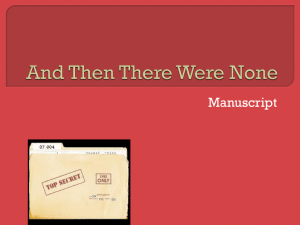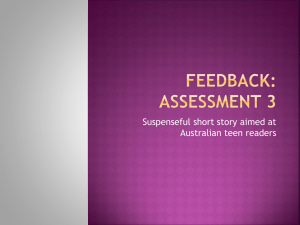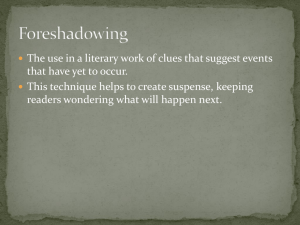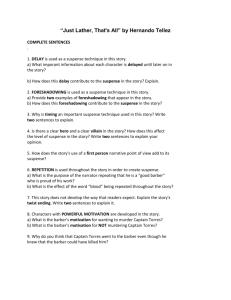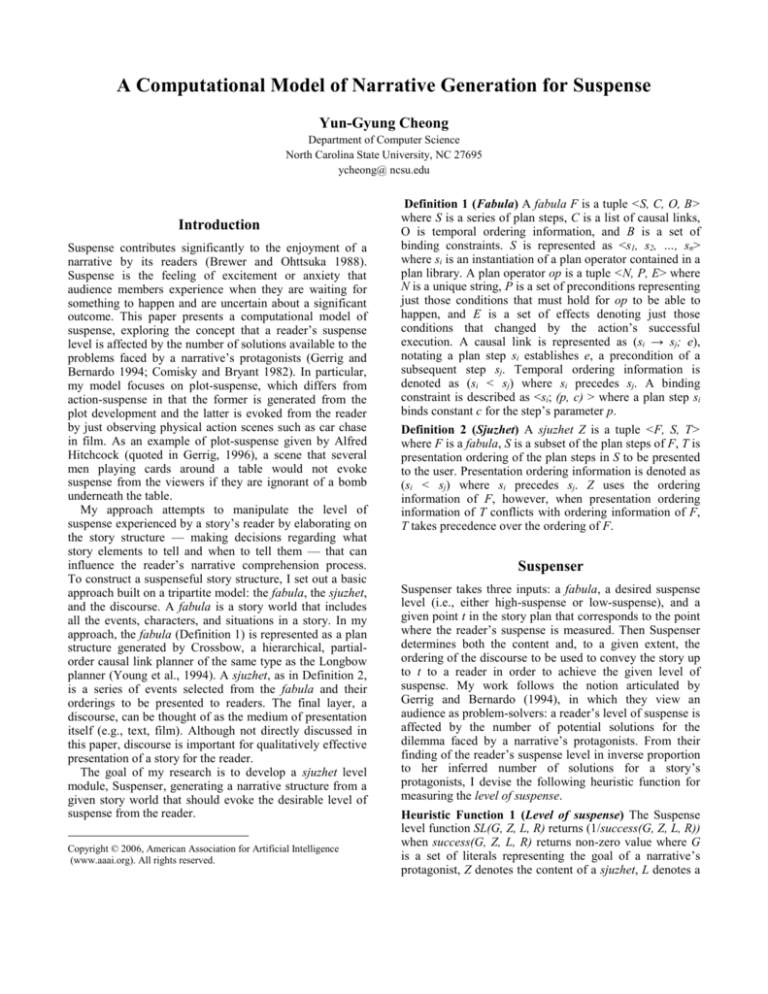
A Computational Model of Narrative Generation for Suspense
Yun-Gyung Cheong
Department of Computer Science
North Carolina State University, NC 27695
ycheong@ ncsu.edu
Introduction
Suspense contributes significantly to the enjoyment of a
narrative by its readers (Brewer and Ohttsuka 1988).
Suspense is the feeling of excitement or anxiety that
audience members experience when they are waiting for
something to happen and are uncertain about a significant
outcome. This paper presents a computational model of
suspense, exploring the concept that a reader’s suspense
level is affected by the number of solutions available to the
problems faced by a narrative’s protagonists (Gerrig and
Bernardo 1994; Comisky and Bryant 1982). In particular,
my model focuses on plot-suspense, which differs from
action-suspense in that the former is generated from the
plot development and the latter is evoked from the reader
by just observing physical action scenes such as car chase
in film. As an example of plot-suspense given by Alfred
Hitchcock (quoted in Gerrig, 1996), a scene that several
men playing cards around a table would not evoke
suspense from the viewers if they are ignorant of a bomb
underneath the table.
My approach attempts to manipulate the level of
suspense experienced by a story’s reader by elaborating on
the story structure — making decisions regarding what
story elements to tell and when to tell them — that can
influence the reader’s narrative comprehension process.
To construct a suspenseful story structure, I set out a basic
approach built on a tripartite model: the fabula, the sjuzhet,
and the discourse. A fabula is a story world that includes
all the events, characters, and situations in a story. In my
approach, the fabula (Definition 1) is represented as a plan
structure generated by Crossbow, a hierarchical, partialorder causal link planner of the same type as the Longbow
planner (Young et al., 1994). A sjuzhet, as in Definition 2,
is a series of events selected from the fabula and their
orderings to be presented to readers. The final layer, a
discourse, can be thought of as the medium of presentation
itself (e.g., text, film). Although not directly discussed in
this paper, discourse is important for qualitatively effective
presentation of a story for the reader.
The goal of my research is to develop a sjuzhet level
module, Suspenser, generating a narrative structure from a
given story world that should evoke the desirable level of
suspense from the reader.
Copyright © 2006, American Association for Artificial Intelligence
(www.aaai.org). All rights reserved.
Definition 1 (Fabula) A fabula F is a tuple <S, C, O, B>
where S is a series of plan steps, C is a list of causal links,
O is temporal ordering information, and B is a set of
binding constraints. S is represented as <s1, s2, …, sn>
where si is an instantiation of a plan operator contained in a
plan library. A plan operator op is a tuple <N, P, E> where
N is a unique string, P is a set of preconditions representing
just those conditions that must hold for op to be able to
happen, and E is a set of effects denoting just those
conditions that changed by the action’s successful
execution. A causal link is represented as (si → sj; e),
notating a plan step si establishes e, a precondition of a
subsequent step sj. Temporal ordering information is
denoted as (si < sj) where si precedes sj. A binding
constraint is described as <si; (p, c) > where a plan step si
binds constant c for the step’s parameter p.
Definition 2 (Sjuzhet) A sjuzhet Z is a tuple <F, S, T>
where F is a fabula, S is a subset of the plan steps of F, T is
presentation ordering of the plan steps in S to be presented
to the user. Presentation ordering information is denoted as
(si < sj) where si precedes sj. Z uses the ordering
information of F, however, when presentation ordering
information of T conflicts with ordering information of F,
T takes precedence over the ordering of F.
Suspenser
Suspenser takes three inputs: a fabula, a desired suspense
level (i.e., either high-suspense or low-suspense), and a
given point t in the story plan that corresponds to the point
where the reader’s suspense is measured. Then Suspenser
determines both the content and, to a given extent, the
ordering of the discourse to be used to convey the story up
to t to a reader in order to achieve the given level of
suspense. My work follows the notion articulated by
Gerrig and Bernardo (1994), in which they view an
audience as problem-solvers: a reader’s level of suspense is
affected by the number of potential solutions for the
dilemma faced by a narrative’s protagonists. From their
finding of the reader’s suspense level in inverse proportion
to her inferred number of solutions for a story’s
protagonists, I devise the following heuristic function for
measuring the level of suspense.
Heuristic Function 1 (Level of suspense) The Suspense
level function SL(G, Z, L, R) returns (1/success(G, Z, L, R))
when success(G, Z, L, R) returns non-zero value where G
is a set of literals representing the goal of a narrative’s
protagonist, Z denotes the content of a sjuzhet, L denotes a
plan library, R is an integer representing a reasoning bound,
and success(G, Z, L, R) returns the number of paths to
make G true with given Z and R. When success(G, Z, L, R)
returns 0, SL(G, Z, L, R) returns 0.
In order to model the reader’s inference process and
anticipation of the protagonists’ success, Suspenser uses
Crossbow to model the reader’s plan-related reasoning
processes. Prior work has provided strong evidence that
human task reasoning is closely related to partial-order
planning algorithms (Rattermann, 2001) and that
refinement search (Kambhampati et al, 1995), the type of
plan construction process performed by Crossbow, can be
used as an effective model of the plan reasoning process
(Young, 1999).
Refinement search (Kambhampati, 1995) views the
planning process as search through the plan space
represented as a directed acyclic graph composed of nodes
denoting partial plans. In our system, the root node of the
graph is a partial plan that has plan steps as the content of a
given sjuzhet; leaf nodes are either complete plans without
flaws or plans with flaws that cannot be repairable due to
inconsistency in the plan; internal nodes are partial plans
with a number of flaws. A flaw in Crossbow is either a
precondition of some step that has not been established by
prior step in the plan, or a causal link that is threatened (i.e.,
undone) by the effect of some other step in the plan. In the
graph, a child node is a refinement of its parent node to
repair a single flaw in the parent plan. When the flaw is an
open precondition, a causal link is established from either
an existing step in the plan or an instantiated operator in
the plan library which has an effect that can be unified with
the precondition; in the second case, the instantiated step is
added to the parent plan. When the flaw is a threatened
causal link, a temporal ordering to resolve the threat is
added or binding constraints are added to separate the
threat involved steps so that no conflicts arise. This
refinement search process continues until either it finds all
the complete plans consistent with the given sjuzhet or the
number of searching exceeds the reader’s reasoning limit.
To construct the sjuzhet that enables the reader to find
the minimum number of solutions for a story’s protagonist,
Suspenser processes in two phases: a skeleton building step
and a story structure building step. In the skeleton building
step, Suspenser identifies the skeleton of the fibula—a set
of core story events that cannot be eliminated without
harming the understandability of a story—by rating each
individual event’s importance based on the event’s causal
relationship to the protagonists’ goals. In the second phase,
Suspenser finds additional plan steps α according to
Hypothesis 1, which confine available solutions for the
protagonist’s goal. Suspenser also extracts plan steps β in
the skeleton, according to Hypothesis 2, which help the
reader find more solutions for the goal within her cognitive
limit. When α and β are identified, Suspenser composes the
content of the sjuzhet of (skeleton + α). Suspenser then
modifies the sjuzhet to reflect the presentation ordering (t
< sβ) for each step sβ in β, which means that telling of β is
deferred after t.
Hypothesis 1 SL(G, K+α, L, R) is greater than SL(G, K, L,
R) where G is a set of literals representing the goal of
protagonists, K is a skeleton, L is a plan library, R is an
integer representing reasoning bound, and α is a set of
actions in a given fabula which have effects negating some
literals of G.
Hypothesis 2 SL(G, K-β, L, R) is greater than SL(F, G, K,
L, R, t) where G is a set of literals representing the goal of
protagonists, K is the skeleton, L is a plan library, R is an
integer representing reasoning bound, and β is a set of
actions included in K which have effects unifying some
literals of G.
If these two hypotheses are correct, the sjuzhet generated
in the high-suspense mode by Suspenser should evoke
greater than the suspense level either from a story
produced in the low-suspense model or a story composed
of randomly selected events. To date, I have worked on
the system implementation and an experimental design.
When the system is completed, I will conduct experiments
with human subjects to test their suspense level from the
stories generated by Suspenser, comparing that from the
stories created by humans. I hope that this work will
motivate affective story generation to provide various
emotions for the user.
References
Brewer, W. F. and Ohttsuka, K. 1988. Story structure,
characterization, just world organization, and reader affect
in American and Hungarian short stories. Poetics, 17, 395415.
Comisky, P., and Bryant, J. 1982. Factors involved in
generating suspense. Human Communication Research
9(1):49-58.
Gerrig, R. J. 1996. The Resiliency of Suspense. In
Vorderer, P., Wulff, H. J., & Friedrichsen, M. (Eds.),
Suspense: Conceptualizations, theoretical analyses, and
empirical explorations, 93-105, Lawrence Erlbaum
Associates.
Gerrig, R., and Bernardo, D. 1994. Readers as problemsolvers in the experience of suspense. Poetics, 22, 459-472.
Kambhampati, S., Knoblock, C. A., and Yang, Q. 1995.
Planning as Refinement Search: A Unified Framework for
Evaluating Design Tradeoffs in Partial-Order Planning.
Artificial Intelligence, 76(1-2), 167-238.
Rattermann, M. J., Spector, L., Grafman, J., Levin, H. and
Harward, H. 2002 Partial and total-order planning:
evidence from normal and prefrontally damaged
populations, Cognitive Science; 25(6); 941-975.
Young, R. M., Pollack, M. E. and Moore, J.D. 1994.
Decomposition and causality in partial order planning, in
Proceedings of the Second International Conference on AI
and Planning Systems, 188-193.
Young, R. M. 1999. Using Grice's Maxim of Quantity to
Select the Content of Plan Descriptions, Artificial
Intelligence, No. 115, pp. 215-256.





